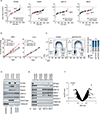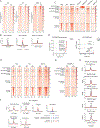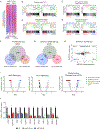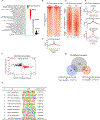STAG2 loss rewires oncogenic and developmental programs to promote metastasis in Ewing sarcoma
- PMID: 34129824
- PMCID: PMC8378827
- DOI: 10.1016/j.ccell.2021.05.007
STAG2 loss rewires oncogenic and developmental programs to promote metastasis in Ewing sarcoma
Abstract
The core cohesin subunit STAG2 is recurrently mutated in Ewing sarcoma but its biological role is less clear. Here, we demonstrate that cohesin complexes containing STAG2 occupy enhancer and polycomb repressive complex (PRC2)-marked regulatory regions. Genetic suppression of STAG2 leads to a compensatory increase in cohesin-STAG1 complexes, but not in enhancer-rich regions, and results in reprogramming of cis-chromatin interactions. Strikingly, in STAG2 knockout cells the oncogenic genetic program driven by the fusion transcription factor EWS/FLI1 was highly perturbed, in part due to altered enhancer-promoter contacts. Moreover, loss of STAG2 also disrupted PRC2-mediated regulation of gene expression. Combined, these transcriptional changes converged to modulate EWS/FLI1, migratory, and neurodevelopmental programs. Finally, consistent with clinical observations, functional studies revealed that loss of STAG2 enhances the metastatic potential of Ewing sarcoma xenografts. Our findings demonstrate that STAG2 mutations can alter chromatin architecture and transcriptional programs to promote an aggressive cancer phenotype.
Keywords: EWS/FLI1; Ewing sarcoma; POU3F2; PRC2; STAG1; STAG2; cohesin; fusion oncoprotein; metastasis.
Copyright © 2021 Elsevier Inc. All rights reserved.
Conflict of interest statement
Declaration of interests None of the authors declare a conflict of interest for this project but report the following relationships. N.V.D. is a current employee of Genentech, Inc., a member of the Roche Group. R.A.Y. is a founder and shareholder of Syros Pharmaceuticals, Camp4 Therapeutics, Omega Therapeutics, and Dewpoint Therapeutics. M.J.A. has financial interests in Monitor Biotechnologies (formerly known as Beacon Genomics). K.S. receives grant funding as part of the DFCI/Novartis Drug Discovery Program, consults for and has stock options in Auron Therapeutics, and consulted for AstraZeneca and Kronos Bio. B.D.C. receives research funding from Gradalis for an unrelated project, and his spouse was previously employed by Shire and Mersana and currently works for Acceleron.
Figures







References
-
- Armentano M, Chou SJ, Tomassy GS, Leingartner A, O’Leary DD, and Studer M (2007). COUP-TFI regulates the balance of cortical patterning between frontal/motor and sensory areas. Nat Neurosci 10, 1277–1286. - PubMed
-
- Armentano M, Filosa A, Andolfi G, and Studer M (2006). COUP-TFI is required for the formation of commissural projections in the forebrain by regulating axonal growth. Development 133, 4151–4162. - PubMed
-
- Aynaud MM, Mirabeau O, Gruel N, Grossetete S, Boeva V, Durand S, Surdez D, Saulnier O, Zaidi S, Gribkova S, et al. (2020). Transcriptional Programs Define Intratumoral Heterogeneity of Ewing Sarcoma at Single-Cell Resolution. Cell Rep 30, 1767–1779 e1766. - PubMed
Publication types
MeSH terms
Substances
Grants and funding
LinkOut - more resources
Full Text Sources
Medical
Molecular Biology Databases

